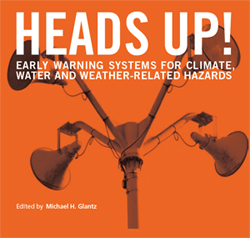Heads Up! Early Warning Systems for Climate, Water and Weather-Related Hazards
Michael H. Glantz, Editor
Paperback, 2007, Beijing: Tsinghua University Press
To order: publications@un.org
The forces of nature can have deadly and damaging consequences for societies and ecosystems that stand in their path. Early warning systems offer one of the best defenses against the adverse effects of climate, water, weather and geologic hazards, although far too often this realization is made after disaster strikes.
Heads Up! provides a useful review of early warning systems in operation today, while exploring a range of hazards including hurricanes, heat waves, floods, droughts, tsunami and volcanoes.
With contributions from an international team of scientists, this practical handbook serves as a valuable contribution to our awareness and understanding of the role early warning systems play in disaster avoidance and reduction.
Published in 2009 by the United Nations University Press, this publication has been edited by Dr. Michael H. Glantz, Director of the Consortium for Capacity Building (CCB) at the University of Colorado in Boulder, Colorado.
Contributors
Michael H. Glantz
Jennifer Boehnert
Thomas Bogdan
Stanley Changnon
S.H.M. Fakruddin
Eve Gruntfest
Mary Hayden
Stefanie Herrmann
Ilan Kelman
Joanie Kleypas
Janet Larsen
Margaret LeMone
Michael McPhaden
Paulette Middleton
Rebecca Morss
Susanne Moser
Lino Naranjo Diaz
Douglas Pattie
Roger Pielke, Jr.
Gregory Pierce
Kevin Trenberth
Tsegay Wolde-Georgis
Qian Ye
Table of Contents
Introduction
Interest in Early Warning
The Precautionary Principle as an Early Warning
What Constitutes an Early Warning System?
Some Tools of the Early Warning Trade
EWS Quick Facts
Threats: The Perils That Compel Early Warning
Perception of the Role of EWSs
The Reality of the Role of EWSs
Surprises
The Future Has Arrived Earlier Than Expected
Strengths, Weaknesses, Opportunities and Constraints Assessment
Climate, Water and Weather Related Hazards
Hurricanes
Severe Winter Storms
Heat Waves
Tornadoes
Nor’easters
El Niño-Southern Oscillation
Vector-Borne Disease
Severe Weather
Fire Danger Index
Anatomy of Australian Bush Fires
Air Pollution in Metropolitan Areas
Dust and Sandstorm Early Warning
Too Much, Too Little
Floods
Droughts
Global Warming
Global Warming
Coral Reef Bleaching
Sea-Level Rise
Integrated Vector Management
Earth Hazards
Tsunamis
Volcano Early Warning Systems
Earthquake Early Warning
Space Weather
U.S. Ultraviolet Forecasts
Concluding Thoughts
Lessons Learned about “Lessons Learned”
Foreseeability of Hazards
References
Essential References for Early Warning Systems
